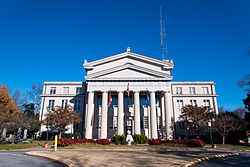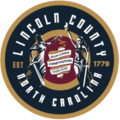Lincoln County, North Carolina | |
|---|---|
 | |
 Location within the U.S. state of North Carolina | |
 North Carolina's location within the U.S. | |
| Coordinates: 35°29′N81°14′W / 35.49°N 81.23°W | |
| Country | |
| State | |
| Founded | 1779 |
| Named after | Benjamin Lincoln |
| Seat | Lincolnton |
| Largest community | Lincolnton |
| Area | |
• Total | 304.87 sq mi (789.6 km2) |
| • Land | 295.85 sq mi (766.2 km2) |
| • Water | 9.02 sq mi (23.4 km2) 2.96% |
| Population (2020) | |
• Total | 86,810 |
• Estimate (2024) | 97,611 |
| • Density | 293.4/sq mi (113.3/km2) |
| Time zone | UTC−5 (Eastern) |
| • Summer (DST) | UTC−4 (EDT) |
| Congressional district | 10th |
| Website | www |
Lincoln County is a county located in the U.S. state of North Carolina. As of the 2020 census, the population was 86,810, [1] making it the most populous "Lincoln County" in the United States. Its county seat is Lincolnton. [2] Lincoln County is included in the Charlotte-Concord-Gastonia, NC-SC Metropolitan Statistical Area.
Contents
- History
- Geography
- State and local protected areas
- Major water bodies
- Adjacent counties
- Major highways
- Major infrastructure
- Demographics
- 2020 census
- 2010 census
- Politics
- Law and government
- Office Holders
- Judicial
- General Assembly[38][39]
- Federal Representatives[49]
- Controversy
- Education
- Post-secondary education
- Lincoln County Schools
- Communities
- City
- Town
- Census-designated places
- Unincorporated communities
- Townships
- See also
- References
- Further reading
- External links





